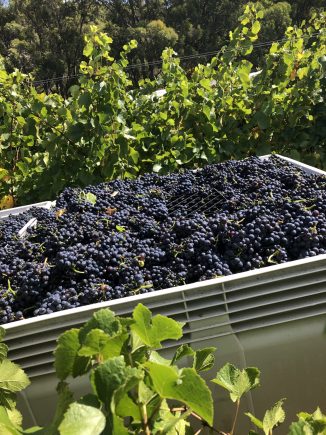And just like that Somerled vintage 2022 has begun!
Finally!
It’s definitely a good couple of weeks behind usual timing but the first of our fruit came off the vines over the weekend.
Here is a quick summary of what’s been keeping Rob busy this week…
Chardonnay
A small parcel of Chardonnay from Alister McMichael’s Romney Park vineyard was picked on Saturday. We first used fruit from this vineyard for our 2020 Chardonnay. Back when we couldn’t get any fruit from Kim Anderson in Charleston after the devastating fires at the end of 2019. Rob was really impressed with the quality of fruit from Romney Park that he’s used a blend of fruit from there along with some from Kim’s vineyard since then.
It looks like Kim’s Chardonnay will be ready to pick next week – some further tests today will confirm the date.
Sauvignon Blanc
Kim picked a lovely lot of his sauvignon blanc grapes for us on Tuesday. It went straight to Lodestone where Rob kept a very close eye on it going through the crusher and then the press. It will be used for our 2022 Sauvignon Blanc (obviously!) as well as our Fumé Blanc (once it’s had a few months in barrel).
Here are some great photos Rob took for you…



Pinot Noir for Sparkling
Paul Henschke’s Pinot Noir at Summertown also came off the vine on Tuesday. Rob will be using this beautiful looking fruit for his 2022 Sparkling white.

Rob will grab a second lot of Pinot Noir from Paul in a week or so once it has ripened a little further. He’ll use this to make his Rosé.
The reds are a couple of weeks away yet. With Pinot Noir for LDR and Pinot dry red as well as the Tempranillo and Graciano grapes for our 2022 Picnic Races Red still to come.
It’s going to be a busy time for Rob and I promise to pin him down for a first-hand update as soon as he comes up for air.
Loving our blog? Sign up for weekly updates straight to your inbox…
[withwine type=’join-mailing-list’]
This next bit I’m including specifically for our newer readers.
I know you old hands have heard this before. So feel free to move on to the latest Wordle… or read on for a quick reminder of how grapes are picked!
Pick me!
The romantics amongst us probably imagine that all grapes are lovingly picked by hand… gently placed into baskets and carried to the winery by dedicated but carefree workers basking in the glow of the late summer sun. No? Just me?
Well, traditionally grapes have always been picked by hand (I may have taken a little creative licence with the carefree basking). These days though, we also rely pretty heavily on machinery.
But it all depends a bit on the variety and style of wine.
Picking by hand
Hand-picking is obviously the gentlest way to handle grapes at harvest time. It allows the removal of whole bunches – leaving the berries attached to the stalks.
Mechanical harvesting
 Mechanical harvesters work by moving along the row and shaking the vines. This movement causes the berries to fall off their stalks.
Mechanical harvesters work by moving along the row and shaking the vines. This movement causes the berries to fall off their stalks.
There are several benefits to using machine over hand-picking.
Firstly, and most obviously, it allows grapes to be picked at a fraction of the cost and time. This can be really important when the grapes have reached their desired ripeness and need to be removed quickly.
Secondly, these machines can pick through the night when temperatures are cooler. As we know, oxidation can occur at higher temperatures, so picking at night is often a better option if daytime temperatures are high. Ideally, grapes should be picked at an ambient temperature of between 8 and 16 degrees Celcius.
So why pick by hand at all?
There are a few situations for which mechanical harvesters cannot be used…
Some vineyards are simply inaccessible to heavy equipment. Steep slopes can make mechanical harvesting impossible.
In other cases, the winemaking technique dictates the use of whole bunches. For example:
- in the production of premium sparkling wine where whole bunch pressing is used to extract the juice
- when red wines are made using carbonic maceration
- where there is a need to select only certain bunches or parts of bunches due to the presence of disease.
Carbonic maceration is a winemaking technique in which whole grapes are fermented in a carbon dioxide rich environment prior to crushing. The result are wines that are fruity in aroma and flavours, sometimes with a distinct banana aroma. They lack tannins, and deep color.
So which method does Rob use?
 The Pinot Noir Rob uses for his Sparkling and Rose along with his Sauvignon Blanc are always hand-picked.
The Pinot Noir Rob uses for his Sparkling and Rose along with his Sauvignon Blanc are always hand-picked.
The main principle is to finish up with fine, delicate, low colour juice. The tannins also need to be low. Since colour, tannins and compounds leading to a bigger-bodied juice/wine are in the skins, it makes sense to keep berries/skins intact until the bunches get to the press. Machine harvesting always causes rupture of skins and release of juice, no matter how well it’s done.
For red wines and bigger-bodied whites such as Chardonnay, this extra extraction is not a problem, so all the varieties for dry red (Shiraz, Tempranillo and Pinot) are machine harvested. It’s also beneficial for Chardonnay to be machine picked as it helps to give more body, and the slight extra tannin is easily absorbed with the barrel ageing.

Good one Maree, nothing wrong with a bit of basking